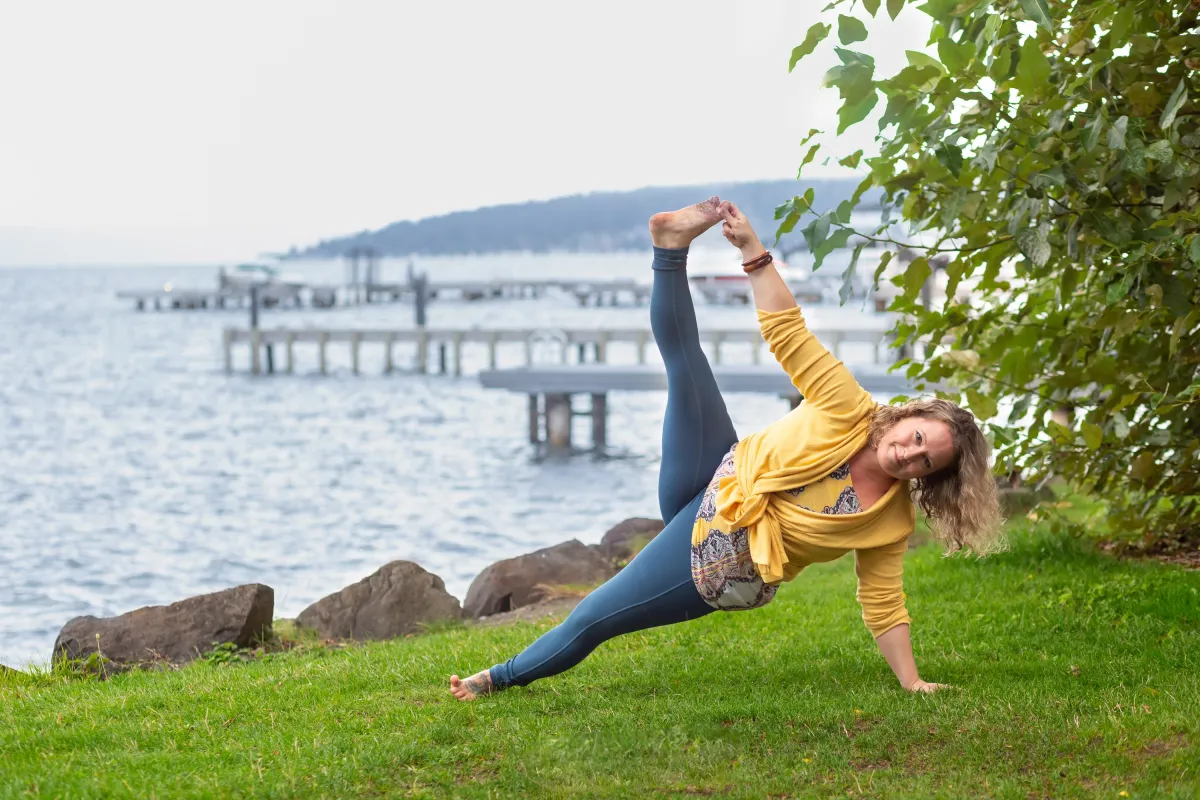Ideas for You
personalizing yoga for yourself

The Perfect Yoga Body: going on a snipe hunt
“ Yoga teaches you how to listen to your body.” - Mariel Hemingway
Don’t we all step onto the mat at least once, if not often, with visions of ourselves mirroring the beautifully symmetrical, graceful, perhaps even acrobatic, feats of flexibility we see in photographs? In fact, many of us were lured to yoga in the first place with grand promises, or at least overt implications, that we could one day be perfectly sculpted into the “yoga body” of our dreams. In my years on the mat, as student and teacher, I have realized that in practical life – unlike filter-fancified media – a perfect, symmetrical, yoga body is the yoga version of a snipe hunt.
What Does a “Yoga Body” Look Like? Well, It Depends.
Yoga shares cultural roots with the science of Ayurveda, and it works in a complimentary way with our yoga practice. Ayurvedic theory considers each of us quite unique, and starts by looking at an individual’s natural constitution or make-up – called our prakriti. Our prakriti is like the recipe that makes up our unique individuality. The ingredients of our recipe are called doshas. There are three doshas: Vata, Pitta, and Kapha. And every individual has a slightly different combination of these three for a recipe that makes just the perfect you. One might be primarily Vata, or largely Pitta, or mostly Kapha. One might be equally Vata-Pitta with just a dash of Kapha, or any other combination.
The balanced Vata dosha expresses itself as
creative,
flexible/adaptable, and
naturally slender, even lanky, body-types.
Annie Carpenter is likely* of predominately Vata constitution.
The balanced Pitta dosha expresses itself as
driven/highly motivated,
strong/athletic, and
naturally well proportioned/medium built body-types.
Kathryn Budig is probably* primarily Pitta dosha.
The balanced Kapha dosha expresses itself as
grounded,
reliable/dependable, and
naturally bigger bodied/stout/voluptuous body-types.
Jessamyn Stanley is likely* principally Kapha constitution.
*An Ayurvedic Practitioner would give the most reliable evaluation of anyone’s unique Prakriti make-up; however, I believe these teachers are representative of just how broad the spectrum of “Yoga Body” is in the real world.
The Himalayan Institute has a lovely short video overview of the tridosha theory, if you are interested. Or, for a more thorough outline of characteristics representative of the doshas, check out Ayurveda & Dosha Types for Beginners from MindBodyGreen.
There is so much more depth to Ayurveda, but for my point here, it is enough to know that every body that walks into the yoga studio is different. And that is as it should be.
Therefore, it stands to reason that every body is going to look a little different in each posture. And that is as it should be.
Want to come to the mat with a more accurate vision in mind for what a yoga body looks like? Skip popular, mainstream media, and do a quick online search for #whatayogilookslike, a campaign from Yoga International with Yoga and Body Image Coalition designed to provide us with a more accurate representation of what yoga bodies look like in real, practical life.
Let’s Rethink Flexibility
Somewhere along the way, the term flexibility has become synonymous with images of pretzel-like postures worthy of Cirque du Soleil. So, when folks tell me either, “I am not flexible enough to do yoga,” or “how do I get as flexible as so-and-so,” the words of Inigo Montoya always come to mind.
You keep using that word. I do not think it means what you think it means.
[For those unfamiliar with The Princess Bride reference, treat yourself to a a good laugh and check out this great 80’s movie.]
Flexibility refers to a muscle’s ability to adapt to the body’s needs. That is, to contract and be strong or to stretch and still be strong, depending on the way the body is standing, sitting, laying, or moving at any given time. To engage or relax as needed. Flexibility is about a muscle’s range of motion and adaptability.
This is not to be confused with hyper-mobility (a predisposition – that is typically genetic – to über mobile joints), or lax ligaments (often a result of poor body mechanics or injury) – both of which allow excessive range of motion within a joint. For a well-written description of hyper-mobility vs. flexibility, read Jenni Rawlings’ article for YogaDork.
Insider secret: hyper-mobile people can actually stress out yoga teachers in class. It’s true. Hyper-mobility often results in dysfunctional movement patterns that can be so engrained and subtle that they are hard to improve. Also, more mobility = less stability, which translates in teacher brains as “prone to injury” (especially in hot yoga classes). So, while you may think you’d like me to tell you the secret to being “as flexible as so-and-so”, know that I may not want you to move like so-and-so… And if you are so-and-so: Yes, I see you, and I know how hard it can be to stretch tight muscles (because though your joints have lots of range of motion, your muscles get stuck just like anyone else’s).
Yup, you read that right: hyper-mobile folks can actually be muscularly inflexible. And if that is you, and I see you in class, I promise to offer as many cues as I can to help you improve your joint stability so you can get the muscular flexibility you need.
Using Yoga to Cleanse, Sculpt, and Perfect the Body
It is fairly common to see yoga classes, workshops, and programs advertised as ways to help us cleanse, sculpt, or otherwise perfect and correct whatever we believe is wrong with our body. While I doubt anyone who has used these concepts to pitch a program ever had ill intentions, we have certainly set a tone we all might want to rethink…
We also often see translations of traditional texts such as the Hatha Yoga Pradipika use terms like “cleanse” and “purify imperfections.” While these concepts (and some of the practices that are linked to them) are not inaccurate exactly, I would suggest we reconsider using these terms so flippantly in the west. Cultural context gets lost in translation, and in western culture, these terms come loaded with negative connotations – perhaps partly because they are so overused by every beauty / fitness / nutrition marketer.
Bodies do get cleansed and sculpted by yoga asana. Bodies also get healthier movement patterns, increased adaptability, and improved functional strength – all of which get the body that much closer to its natural design for health and balance. I know, the second list doesn’t sound as sexy. It isn’t as marketable for studios. But that doesn’t make it any less true for us. And for some of us, it’s the second list to keep in mind when setting our intentions on the mat.
So Let’s Rethink What Brings Us to the Mat
Many of us have only the aesthetics in mind when we think about why we start our yoga practice. And that makes sense. Outer beauty, sculpted muscles, lean bodies, perfect symmetry, flawless skin and bright smiles are ideals being sold to us all the time. And just like a snipe is a real bird, those examples of beauty do exist, too. But just like sending someone on a snipe hunt is a big fat joke, I think, sometimes, suggesting that everyone can (or even should) have the same lean, sculpted body of [insert-your-own-idealized-ultra-slim-super-flexi-famous-yogi here], is actually a big fat joke on us!
And more importantly, it can turn our attention to the wrong thing. You don’t need to do your yoga like so-and-so. You need to do your yoga in a way that serves you. As you are. Today.
What if the point of being on the mat isn’t aesthetics, but rather function? What if we practice and teach like the point is actually more about…
How much can we use just the right muscles in just the right way to find sthira and sukha (steadiness and ease) in a pose, whichever variation we choose?
How can we adapt our practice to gradually develop more symmetry and bring more balance to the body?
How can we practice in a way that is sustainable for life-long practice instead of just a 21-day get fit challenge?
How would it look and feel if we talked about our yoga practice as a means of regular self-care rather than just sculpting a yoga body for summer?
If you would rather approach your practice or your teaching from a functional vs. aesthetic focus, I highly recommend Bernie Clark’s Your Body, Your Yoga.
Perhaps aesthetics and envisioned ideals are honestly what bring you to the mat. No shame there. For some of us it provides powerful, positive motivation. However, if it was your motivation, but you have found yourself getting discouraged, then it is okay chalk it up to a snipe hunt joke. Shake it off and look into a new intention to hit the mat that is more realistic and sustainable for you.
This isn’t about a single standard of right or wrong, but a giving us each permission to consider what is right or wrong for us individually. It is important to find a studio and teacher whose platform suits you. Or to seek out a yoga therapist if studio yoga is not a good match for you. So, be mindful of what you need and honest about whether teachers (or therapists,) like me) are a good fit or not. (Spoiler alert: it is okay if we are not.)
© 2025 Balanced Mind Body Therapy, LLC. All Rights Reserved. | Privacy Policy | Terms of Service
920 Alder Ave, Suite #201, Sumner, WA 98390, USA
P.O. Box 581, Sumner, WA 98390
(253) 242-9061
margo@mybalancedmindbody.com





